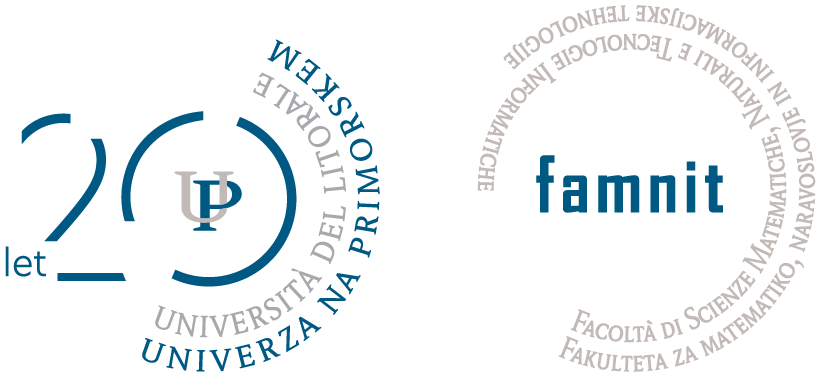Vabimo vas, da se nam pridružite na biomatematičnem popoldnevu, ko bomo na UP FAMNIT gostili nekaj vrhunskih znanstvenikov s področja matematične in teoretične biologije.
Biomatematično popoldne na UP FAMNIT bo potekalo
v petek, 29.11.2013, v Veliki predavalnici UP FAMNIT.
Program srečanja:
14.30-15.10 | Reinhard Bürger: Models for the evolution of local adaptation and differentiation with gene flow |
15.15-15.45 | Andreja Ramšak: Phylogeographic structure and niche occupation: case study Pelagia noctiluca |
15.45-16.15 | Coffee break |
16.15-16.45 | Ryszard Rudnicki: On a sexual model of phenotypic evolution |
16.50-17.20 | Vitaly Volpert: Nonlocal reaction-diffusion equations in populations dynamics |
17.25-17.55 | Andreas Deutsch: Models for collective cell behaviour |
Abstracts
Reinhard Bürger, Department of Mathematics University of Vienna, Austria
In subdivided populations, adaptation to a local environment may be hampered by maladaptive gene flow from other subpopulations. First, we study a continent-island model in which an ancestral population sends migrants to a colony exposed to a different environment. At an isolated locus, i.e., unlinked to other loci under selection, a locally beneficial mutation can be established and maintained only if its selective advantage exceeds the immigration rate of alternative allelic types. We show that, if a beneficial mutation arises in linkage to a locus at which a locally adapted allele is already segregating in migration-selection balance, the new mutant can invade and be maintained under much higher immigration rates than predicted by one-locus theory. We deduce the maximum amount of gene flow that admits the preservation of the locally adapted haplotype on the strength of recombination and selection. We then extend some of these results to bidirectional migration between two demes and derive the equilibrium configurations and bifurcation patterns for important limiting cases.
Andreja Ramšak, Marine Biology Station, Piran, Slovenia
Mass occurencies of scyphozoan medusae in the last decades stimulated interest of phylogeographers to reveal spatial distribution of their genetic lineages and historical demographic processes. In this regard the marine environement is very challenging since planctonic larvae may reflect contemporary oceanographic conditions, while species with restricted dispersion may reflect historical processes. Most of the scyphozoan species have metagenetic life cycle, but Pelagia noctiluca is exception being holoplanctonic. Phylogeographic analysis on COI revealed two clades and high haplotype diversity and lack of isolation by distance. Phylogenetic analysis revealed two reciprocally monophyletic clades due to past splitting and followed by gene flow between Atlantic and Mediteranean over the notorious biogeographic barrier of Gibraltar Straight. The potential distribution of the phylogenetic clades were used to assess possible niche and subtle differences among suitable niches can be valuable source of information connected with unique history of the lineages.
Joint work with Ezequiel Ale, Amanda F. Cunha, Antonio C. Marques, Alenka Malej, André C. Morandini.
Ryszard Rudnicki, Institute of Mathematics, University of Silesia, Katowice, Poland
We consider an individual based model of phenotypic evolution in hermaphroditic populations which includes random and assortative mating of individuals. By increasing the number of individuals to infinity we obtain a nonlinear transport equation, which describes the evolution of distribution of phenotypic traits. Existence of an one-dimensional attractor is proved and the formula for the density of phenotypic traits in the limiting (asymptotic) population is derived in some particular case. The talk is based on a manuscript: R. Rudnicki, P. Zwolenski, Model of phenotypic evolution in hermaphroditic populations.
Vitaly Volpert, Institut Camille Jordan, University Lyon 1, France
Darwin illustrated his theory about emergence and evolution of biological species with a diagram. It shows how species exist, evolve, appear and disappear. The goal of this presentation is to give a mathematical interpretation of this diagram and to show how it can be reproduced in mathematical models. It appears that conventional models in population dynamics are not sufficient, and we introduce new models which take into account local, nonlocal and global consumption of resources, and models with space and time dependent coefficients.
Andreas Deutsch, Centre for Information Services and High Performance Computing, Technical University Dresden
We introduce cellular automata as models for collective behaviour in interacting cell populations. We focus on mechanisms of collective cell migration and invasion and demonstrate how analysis of the models allows for prediction of emerging properties at the cell population level. Finally, we discuss applications of the invasion models to glioma tumours.
Reference: A. Deutsch, S. Dormann: Cellular Automaton Modeling of Biological Pattern Formation: Characterization, Applications, and Analysis, Birkhäuser, Boston, 2005
Za dodatne informacije lahko pišete na barbara.boldin@upr.si.

